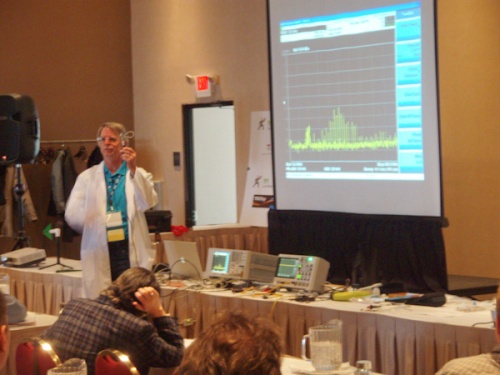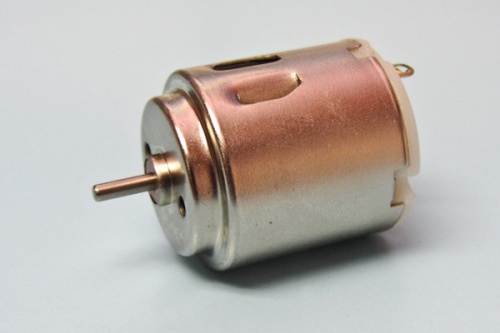Always on the lookout for useful, but inexpensive test equipment, I recently ran across the Triarchy Technologies USB spectrum analyzer, model TSA5G35. The one thing that really struck me was the whole thing was built into a USB dongle, just a little larger than a memory stick. What’s more, the advertised frequency range was 1 MHz to 5.35 GHz. This, I had to see for myself.
So, is a spectrum analyzer no larger than a pack of chewing gum that you can carry in your pocket good enough for EMC analysis and troubleshooting? For a total cost of $599 (through their store on eBay), I decided to take a chance and run this remarkable PC-based analyzer through the ringer.
 Figure 1 – Photo showing the analyzer with supplied USB extension cable and 30 dB attenuator.
Figure 1 – Photo showing the analyzer with supplied USB extension cable and 30 dB attenuator.
 Figure 2 – A screen capture of a series of 16 MHz oscillator harmonics.
Figure 2 – A screen capture of a series of 16 MHz oscillator harmonics.
SPECIFICATIONS – Basic specifications include frequency coverage of 1 MHz to 5.35 GHz, resolution bandwidths of 50 through 500 kHz (not selectable), frequency spans from 1 MHz to 1 GHz, input level range of -110 to +30 dBm (using the supplied 30 dB attenuator for the higher power levels), and typical noise levels of -80 to -100 dBm (depending on the span and RBW). The maximum power level is +20 dBm for 1 minute (without the external attenuator) and +/- 25 VDC, which is excellent protection for this little instrument. The reference level range is -60 dBm to 0 dBm (no external attenuator) or -30 dBm to +30 dBm (with the external attenuator. the usable display range is 80 dB with a noise floor of -115 dBm at a 5 MHz span and -60 dBm reference level at 1 GHz. Amplitude accuracy is specified at less than 3 dB. All in all, not to bad for this little guy.
For more of this hands-on review on Test & Measurement World, click here…
 Technician, Casey Lockhart running a radiated emission test at one of the 10m chambers. Photo courtesy BCBR (© Jonathan Castner).
Technician, Casey Lockhart running a radiated emission test at one of the 10m chambers. Photo courtesy BCBR (© Jonathan Castner).
 Figure 1 – Photo showing the analyzer with supplied USB extension cable and 30 dB attenuator.
Figure 1 – Photo showing the analyzer with supplied USB extension cable and 30 dB attenuator.
 Jim Blaha from GE Medical manages the symposium and is providing introductory comments.
Jim Blaha from GE Medical manages the symposium and is providing introductory comments.

 Here I am explaining why pigtail shield connections cause common-mode currents resulting in radiated emissions.
Here I am explaining why pigtail shield connections cause common-mode currents resulting in radiated emissions.



